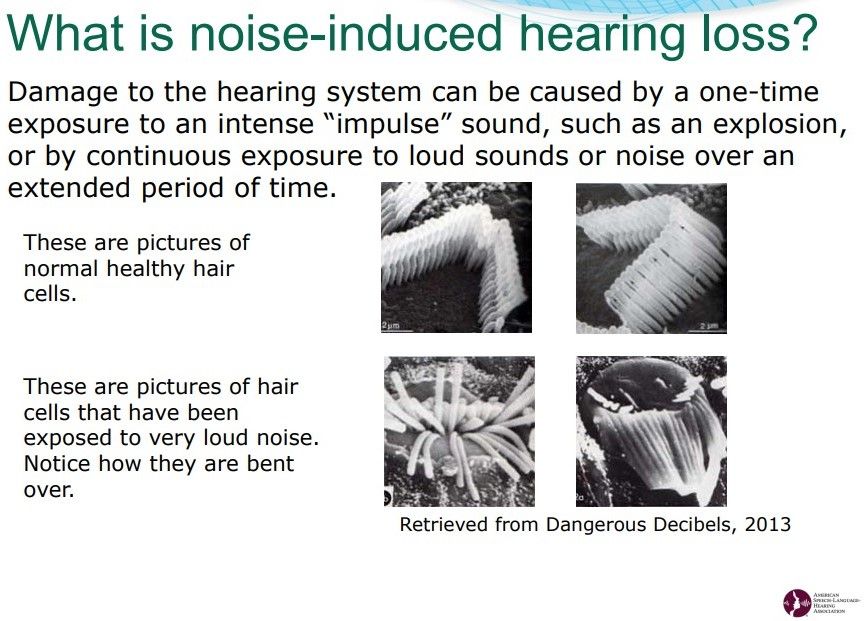
14% of United States adults aged 20-69, one in three adults worldwide and approximately 1 in 3 people in the United States between 65 and 74 have measurable hearing loss. Nearly half of those older than 75 have difficulty hearing.
How do you keep your hearing as your body ages?
Here’s what your ears need to know about:
- How do we hear?
- What causes common hearing problems?
- How can we keep our hearing?
- How can we restore our hearing?
Here’s How We Hear
Hearing is your amazing ability to change sound waves in the air into electrical signals which are passed by your auditory nerve to your brain. The National Institute of Health (NIH) describes the six complex steps below or you can watch and hear their awesome short video, Journey of Sound to the Brain.
- Sound waves enter the outer ear and travel through a narrow passageway called the ear canal, which leads to the eardrum.
- The eardrum vibrates from the incoming sound waves and sends these vibrations to three tiny bones in the middle ear. These bones are called the malleus, incus, and stapes. [Amazingly, these evolved from reptilian jaw bones. You can see and hear how that happened in this five minute evolution video! As mammalian eating habits evolved from their reptilian ancestors, one bone from the lower and one from the upper jaw (the articular and quadrate bones) lost their purpose in the jaw joint and were put to new use in the middle ear.]
- The bones in the middle ear amplify sound vibrations and send them to the cochlea, a snail-shaped structure filled with fluid, in the inner ear. An elastic partition runs from the beginning to the end of the cochlea, splitting it into an upper and lower part. This partition is called the basilar membrane because it serves as the base, or ground floor, on which key hearing structures sit.
- Once the vibrations cause the fluid inside the cochlea to ripple, a traveling wave forms along the basilar membrane. Hair cells—sensory cells sitting on top of the basilar membrane—ride the wave. Hair cells near the wide end of the snail-shaped cochlea detect higher-pitched sounds, such as an infant crying. Those closer to the center detect lower-pitched sounds, such as a large dog barking.
- As the hair cells move up and down, microscopic hair-like projections (known as stereocilia) that perch on top of the hair cells bump against an overlying structure and bend. Bending causes pore-like channels, which are at the tips of the stereocilia, to open up. When that happens, chemicals rush into the cells, creating an electrical signal.
- The auditory nerve carries this electrical signal to the brain, which turns it into a sound that we recognize and understand.
What Causes Common Hearing Problems?
Although noisy occupations such as warfighting, construction, mining, and manufacturing are primary causes of hearing loss in adults, nonoccupational noise also can damage hearing.

- Loud Noise-Induced Hearing Loss. Sounds over 85 decibels (dB) can cause cumulative and permanent damage by damaging your hair cells resulting in a loss of perception of a narrow range of frequencies or impaired perception of sound including sensitivity to sound or ringing in the ears. Sounds over 120dB are particularly dangerous. Sounds over 130dB cause pain. Loud noises can come from:
- Hair dryers, food processors (~90-100dB)
- Motorcycles, snowmobiles, chainsaws and lawn mowers (~90-100 dB)
- NASCAR races from stands (~100 dB)
- Venues playing loud music
- MP3 music players at max volume (~105 dB) at home or in movie theaters, health clubs, dance clubs, bars, and amusement centers
- Rock concerts (~110 dB)
- Jet plane engines at takeoff (~120dB)
- Screaming babies (~130 dB)
- Jackhammers (~130 dB)
- Firecrackers and shotgun blasts (~140 dB) at three feet away
- Explosions (>140 dB). Over 100 miles away from its source, the Krakatoa volcanic explosion registered 172 dB.
- Age-related Hearing Loss (Presbycusis) — High blood pressure or diabetes can contribute to hearing loss.
- Medications that are toxic to the sensory cells in your ears (for example, some chemotherapy drugs) can also cause hearing loss.
- Rarely, age-related hearing loss can be caused by abnormalities of the outer ear or middle ear. Such abnormalities may include reduced function of the tympanic membrane (the eardrum) or reduced function of the three tiny bones in the middle ear that carry sound waves from the tympanic membrane to the inner ear.
- Ear Infections — Ear infections which cause fluid to leak from the ear are serious and can be fatal.
- Ear Injuries — Q-Tips and bobby pins can damage your eardrums. Sudden changes in air pressure are hazardous too.
- Circulatory System Disorders — The health of your ears is connected to the health of your heart, arteries, and veins. Restricted blood flow to the inner ear causes permanent damage over time.
Of note, Tinnitus is the perception of noise or ringing in the ears. A common problem, tinnitus affects about 15 to 20 percent of people. Tinnitus isn’t a condition itself — it’s a symptom of an underlying condition, such as age-related hearing loss, ear injury or a circulatory system disorder.
How Can We Keep Hearing?
The American Speech Language Hearing Association (ASHA) recommends the following to protect your hearing:
- Turn it down, walk away, and protect your ears — are the three strategies recommended by Dangerous Decibels, an evidence-based intervention program that changes knowledge, attitudes, beliefs, and behaviors of youth and adults for the prevention of noise-induced hearing loss and tinnitus.
- Use noise-protection devices such as earmuffs and custom-fit earplugs which each reduce noise by 15-30 dB. Custom-fit earplugs and earmuffs can be combined for greater protection around screaming babies.
- Follow safe listening practices to music.
- Listen to sounds at 70 dBA or lower for as long as you want.
- Sounds at 85 dBA can lead to hearing loss if you listen to them for more than 8 hours at a time.
- Sounds over 85 dBa can damage your hearing faster. The safe listening time is cut in half for every 3-dB rise in noise levels over 85 dBA. For example, you can listen to sounds at 85 dBA for up to 8 hours. If the sound goes up to 88 dBA, it is safe to listen to those same sounds for 4 hours. And if the sound goes up to 91 dBA, your safe listening time is down to 2 hours.
- Minimize the use of pain relievers. Researchers speculate that the pain relievers may be damaging the cochlea, the snail-shaped hearing mechanism in your inner ear. Dr. Sharon Curhan, instructor in medicine at Harvard Medical School, studies the impact of pain relievers on hearing. She raises the following concerns:
- “Acetaminophen may deplete the antioxidant glutathione, which protects the cochlea from damage.”
- “Ibuprofen can reduce blood flow to the cochlea, which could result in cellular damage and cell death.”
- If you need to clean earwax from your ears, use the irrigation technique instead of Q-Tips.
Hearing Restoration
Current technology to restore and enhance hearing includes:
- Hearing Aids — electronic instruments in or behind your ear which make sounds louder.
- Cochlear Implants — Cochlear (COKE-lee-ur) implants are small electronic devices surgically implanted in the inner ear that help provide a sense of sound to people who are profoundly deaf or hard-of-hearing.
- Bone Anchored Hearing Systems that bypass the ear canal and middle ear are designed to use your body’s natural ability to transfer sound through bone conduction. The sound processor picks up sound, converts it into vibrations, and then relays the vibrations through your skull bone to your inner ear.
- Hearing Augmentation from wearables such as NeoSensory’s wristband and vest provides the ability to hear more than we currently experience with our ears.
Scientists are making additional interesting discoveries.
- It is possible to restore hearing in mice by resetting the auditory cortex to an early childhood state.
- Harvard researchers and Frequency Therapeutics (NASDAQ: FREQ) have discovered how to reprogram the inner ear to regrow hair cells, reducing hearing loss.
- The Hearing Restoration Project, an international research consortium, is investigating the regeneration of sensory cells in the ear (hair cells) as a cure for hearing loss and tinnitus. To succeed, they’ll also need to have them restored in the proper pattern.
- Decibel Therapeutics in collaboration with Regeneron is advancing a number of regenerative medicines through its pipeline.
- Frequency Therapeutics is working on a regenerative treatment for sensorineural hearing loss.
- Tickling or stimulating your ear can calm the vagus nerve, balancing the parasympathetic and sympathetic nervous system, thus calming your body and brain.
This concludes today’s article on ear care. As your reward for hearing us out and focusing on keeping your health, try the five free sessions on brain.fm, an internet channel which plays music scientifically designed to optimize brain performance. Alternatively, you can find out what weird things people do with stretched ear lobes.
